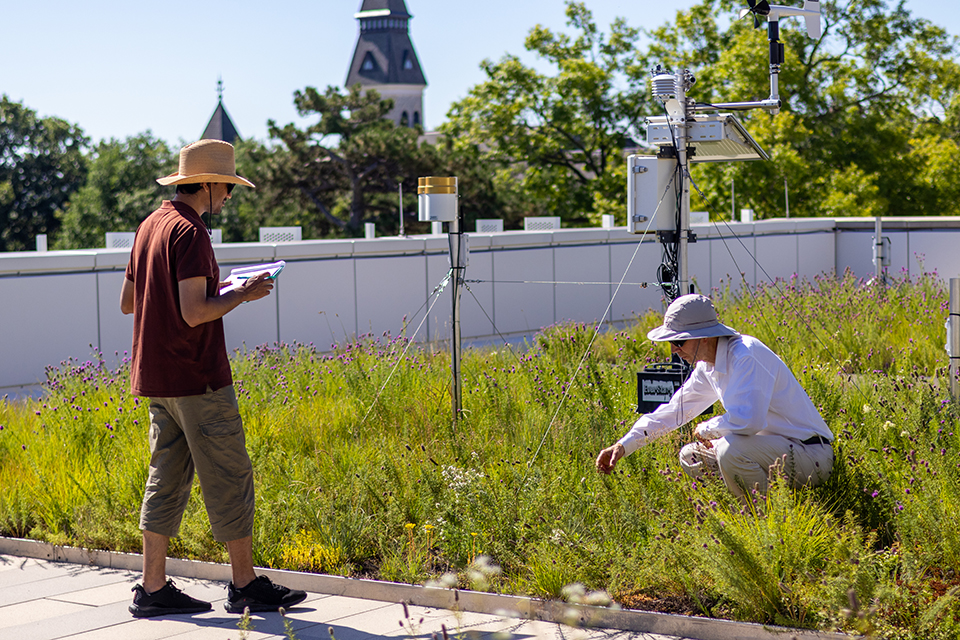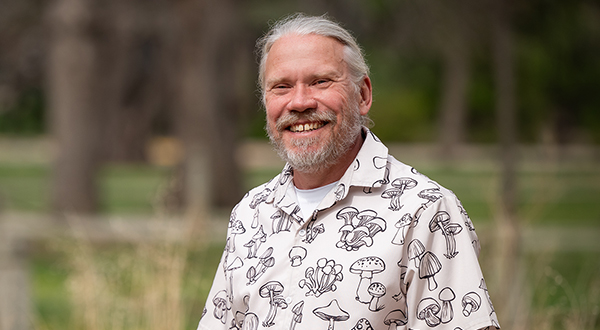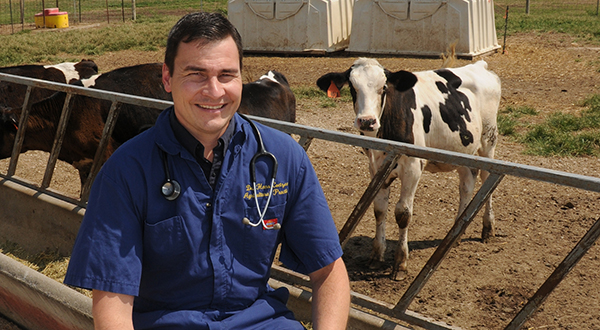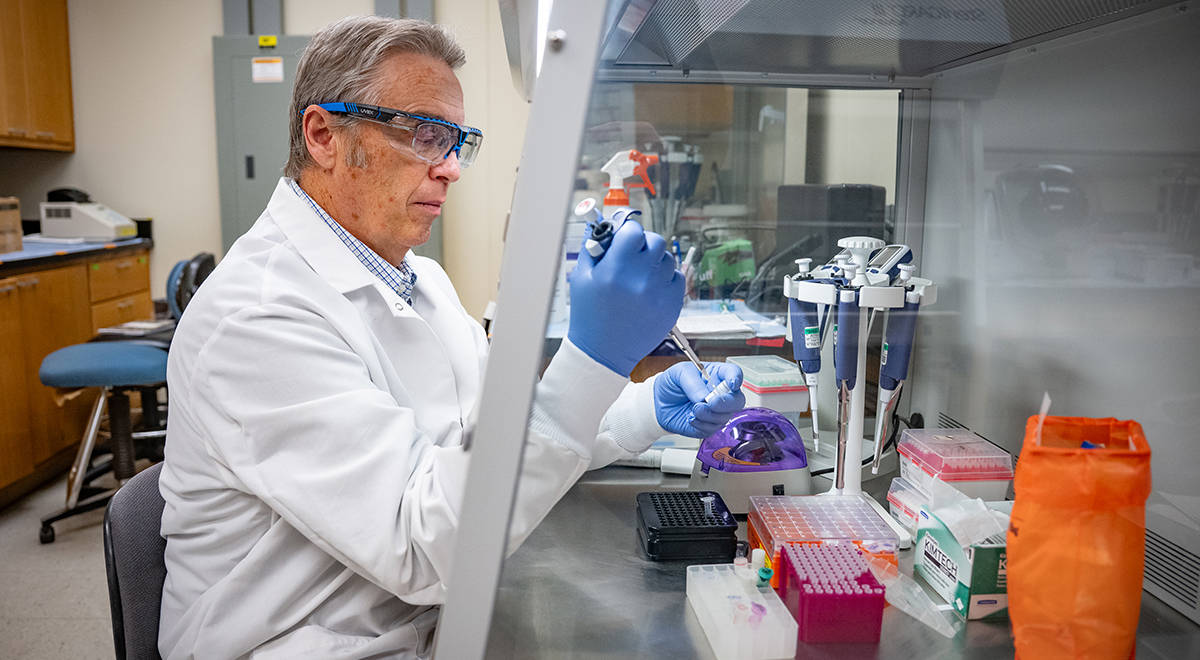Atop K-State's dynamic and experimental green roofs, this professor grows more than just plants
Lee Skabelund named to American Society of Landscape Architects' 2025 class of fellows.
Lee Skabelund insists that he's not a scientist.
Instead, over more than three decades as a designer, educator, mentor and service-oriented community member in landscape architecture — with the last 20 years at Kansas State University — Skabelund has focused on applying ideas from ecology and other sciences to planning and design.
The professional landscape architect is most pleased with the projects and people he has helped influence as a landscape architect who bridges the sometimes-chaotic messiness of nature and the planned purposefulness of human infrastructure, particularly through green infrastructure and green roof projects at K-State.
"Some people look at these projects and say they're messy — that it's chaotic," said Skabelund, associate professor and Mary K. Jarvis distinguished chair in the College of Architecture, Planning & Design. "I see beauty in the diversity, and a kind of elegance. If you visit a natural system, it's diverse and there's a lot going on. I think our ecosystems and our designs should support that natural system."
In recognition of that distinguished career, the American Society of Landscape Architects recently named Skabelund to its 2025 class of fellows — one of the highest honors in the landscape architecture profession.

Muhaiminul Islam, graduate research assistant, records observations as Lee Skabelund, associate professor and Mary K. Jarvis distinguished chair of landscape architecture, estimates plant coverage on the APDesign Experimental Green Roof above Regnier Hall.
Mixing ecosystem science and landscape design
Skabelund was nominated to the class for outstanding leadership in and knowledge about place-based green infrastructure design, ecological restoration, and landscape architecture education, particularly within the Great Plains region since coming to Manhattan in 2005.
Although he's long been a long-term member of the society, Skabelund's election as a fellow reflects his pioneering contributions in several key areas:
- Research and implementation of green roofs: At K-State, Skabelund developed a premier green roof research facility consisting of six distinct environments. His innovations have influenced design practices across climates with limited water resources and extreme temperatures.
- Ecological restoration and education: Through decades of teaching and mentoring, he has advanced landscape architecture as a critical tool for ecosystem restoration. His work balances science, advocacy and on-the-ground application.
- Leadership and policy contributions: A member of ASLA since 1990, Skabelund has helped shape environmental policy and professional standards through his active roles in ASLA's Ecology and Restoration Professional Practice Network.
"Professor Skabelund has dedicated his career to integrating the science of ecosystems with the art of landscape design," said Michael McClure, dean of the College of Architecture, Planning & Design. "His work has not only shaped landscapes but has also transformed the way our students and communities understand and implement sustainable design."
Skabelund was previously recognized with the 2021 Research Award of Excellence by Green Roofs for Healthy Cities, affirming his research's national and international impact.
Opening doors for the next generation of landscape designer-scientists
During his time at K-State, Skabelund has been a driving force behind several of the Manhattan campus's green roof projects.
With projects including the Memorial Stadium renovation and the APDesign Experimental Green Roof atop Regnier Hall, Skabelund's work shows that rooftop ecosystems can be a small but essential way to promote sustainability and landscape conservation practices in urban settings.
Skabelund points out that most of his projects are but "tiny postage stamps" in the larger landscape, and it will take a lot more proactive efforts on a wide range of concerns to address the world's pressing environmental issues.
"But we have to start somewhere," he said. "If we want to reduce our environmental impact, even small actions can have a big ripple effect. And we can learn a lot from these small systems."
Apart from designing and helping maintain these landscape projects at K-State, Skabelund said he has had the privilege of teaching hundreds of students over the years in his landscape restoration, planting design, and environmental issues and ethics classes, which focus on how students can help heal, conserve and restore the Earth.
"(My students) bring in a lot of knowledge and talent when they come here, and my role has simply been to help them open additional doors of thinking, learning, observation, and exploration."
For Skabelund, his career as a landscape architect has been about much more than determining how to grow adaptive vegetation on green roofs.
It's been about growing the next generation of great landscape architects.
"I'm a gardener, a designer," Skabelund said. "I've never really thought of myself as a scientist in that way, but I get to work with some great scientists, and our students have needed to see that relationship between science and design.
"Seeing how well they do in the profession, that's what has been special," he continued. "They bring in a lot of knowledge and talent when they come here, and my role has simply been to help them open additional doors of thinking, learning, observation, and exploration."
###
Get K-State news in your inbox
Subscribe to receive K-State news directly to your inbox every Monday.


